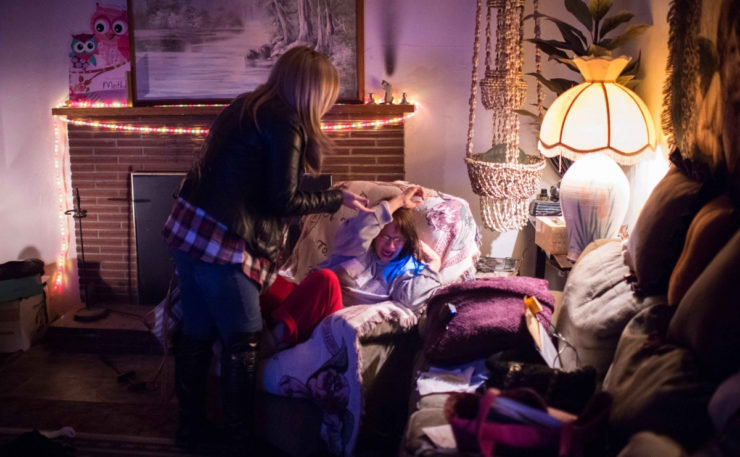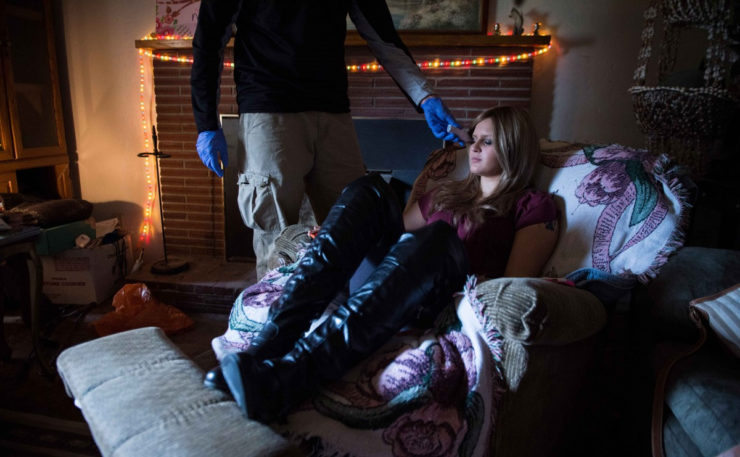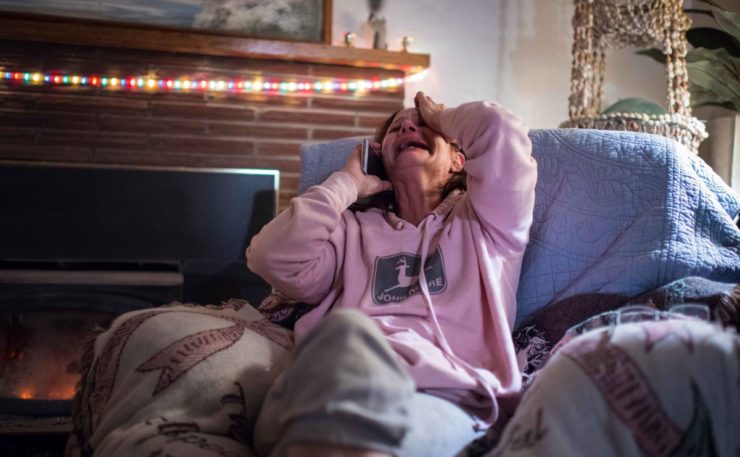In a media landscape quite dependent on quick takes on Twitter and videos transmitted by smartphones, Eli Saslow’s byline offers reassurance of the staying power of the written word. We know what follows will offer a depth of humanity that’s established him as one of America’s premier narrative-driven journalists – and provided proof to those inheriting the field that this art has not been lost.
Saslow, a Washington Post staff writer based in Portland, Ore., won the 2014 Pulitzer Prize for explanatory reporting writing about hunger and dependency in post-recession America. He was a Pulitzer finalist for feature writing 2013 with an intimate exploration of a salesman struggling in the post-recession economy, and again in 2016 for three stories about the human toll of gun violence, natural disaster and a frayed economy.
No matter his subject, he writes in a way that makes a reader feel they are witnessing everyday life in the context of something greater happening in our society. His reporting and writing is simple in approach, but complex in execution.
That definitely applies to one of the pieces from his 2016 Pulitzer finalist collection is “A survivor’s life” – a profile of 16-year-old named Cheyeanne Fitzgerald, whose bright future was altered when she was shot during a mass shooting at her community college in Oregon in October 2015.
Saslow was part of a Post team dispatched to cover the shootings. But long after other reporters moved on, he kept returning to Roseburg, Oregon, to spend time with Cheyeanne and her family as they forged their way through a new and unexpected life. He explores the deep emotional wounds left in the wake of mass shootings through the warts-and-all relationship between Cheyeanne and her mother, Bonnie.
"You want to write details that aren’t just there to fill in what a scene looks like, or to show off that you are there, but that all those details are working toward a greater purpose in the story you are wanting to tell. Every sentence feels reported, and every detail in that sentence feels purposeful."
Saslow says much of his success comes from simply showing up, spending time and paying attention to details – everything from a facial expression, a gesture or an interchange of dialogue that can bring intimacy and humanity to broader social issues.
He spoke with me by phone from his home in Portland. The following is a condensed and edited version of our conversation:
The shooting in Oregon happened in October 2015, and just two months later this longer narrative story ran. How were you able to identify and pull the story together within that time frame?
I didn’t know the timetable when I started, and I didn’t know exactly when I would stop reporting. I went to Roseburg right when the shooting happened. Unfortunately, this has become a consistent part of my job, as I will often go the first few days to write some quick narrative about these mass shootings. I did that in San Bernardino, Roseburg and Newtown. In the first days, though, you are not getting very close to the heart of the stories. You are sort of a witness to the spectacle, but not in how life goes on after such an event. So I knew I wanted to go back.
At first, though – and I think this is how some of the best stories emerge – I didn’t quite know what I was going back for. I thought maybe I would be writing a story about Roseburg as a really gun-centric place, and how people there really value the Second Amendment and their guns, Cheyeanne’s family included. But then I got connected with Cheyeanne’s brother, and I thought I would maybe write about their family and their guns.
But once I got into the house, it was very clear what I was seeing was something else. Then I just kept coming back. I’m lucky because I live in Portland, so I could drive back and forth, as it is about three-and-a-half hours away. But I probably went to Roseburg five times over the course of those six weeks. I would go for about two to three days and just spend all my time with Cheyeanne and her mom. And it became clear this was a story about their relationship and how this event changed their lives.
We might treat these shootings in an antiseptic way, like we hear it and move on, but the truth is obviously so much uglier and so much messier and so much more honest, and so I figured that is the story I wanted to write.

You have written about families forever affected by mass shootings in the past, such as with the Pulitzer Prize finalist work “Into The Lonely Quiet” about Jackie and Mark Barden, whose 7-year-old son, Daniel, died in the Newtown shootings. With a constant series of mass shootings in America today, what are the challenges that journalists face, and perhaps you encountered in this process, about making these stories stand out to a possibly desensitized readership?
It doesn’t always work. One of the reasons that I think the Newtown story resonated and the story about Cheyeanne resonated is because they are both really intimate stories. The reader isn’t spared very much of the experience. These stories are really up-close, intimate examinations of what these situations feel like in these people’s everyday lives. Of course, it takes a lot of reporting and writing, but what it also requires is an extraordinary investment of trust and time of the people that you write about. In both the Bardens’ case in Newtown and Bonnie and Cheyeanne’s case in Roseburg, they let me spend huge amounts of time with them, so much that they eventually sort of forgot I was there. So they went on living their lives, which comes after establishing a trust that comes from just being there again and again.
In the first few hours of spending time with Cheyeanne and her mother, they were not going to be having the same fights with each other, in the same degree and with same sort of honesty, as they would on the sixth day I was there, or the second week I was there, or after they had known me for a month. I communicate that I am not there to judge them but to observe and listen. I think it helps to convey that you care. Not that you are rooting for an outcome, but you care about them as people, and you care that they are enduring something difficult. A huge job for a narrative reporter is finding ways to get people to be comfortable being themselves around you, because then you get to see what their lives are really like instead of people telling you what it is like or presenting one side of what they think their lives are like. You see it for yourself.
There is a scene in the Newtown story where the Bardens are out to breakfast in a diner and another family happens to come in who had a kid in same class. And people told me “That’s crazy” and asked, “How did that happen?” But there were also probably 10 times I went out with the Bardens and that diner scene didn’t happen. A lot of narrative reporting is knowing you are going to spend a lot of time being places and seeing things that are not going to go into the story. But being there allows you to earn your way into witnessing those right moments for the story. If you do that, you can wind up with a story that is really intimate. Hopefully in the end, this story on Cheyeanne and on the one with the Bardens is something akin to readers stepping up to a sheer glass and watching people’s lives in motion.
The story explores Cheyeanne’s cyclical anger and temper, which doesn’t always seem flattering to her in moments. Sometimes profiles on victims don’t always take on those realities as explicitly. Then again, she is also still a teenager, an age when children can be antagonistic towards their parents. So what do you believe is the reason Cheyeanne and her family agreed to have their story told in such a raw manner, and how did you weigh what to include that isn’t the most flattering toward the main character?
That is something I think a lot about and something I worry a lot about. It is really hard to allow a journalist into your life, and I think it has gotten harder. Partly because of the way comments work on our website and on other sites. Being written about is sort of like being hung up for judgment in the public square; it can be a really difficult experience. After the story ran, Bonnie called me and she said, “It’s messy, but it’s the truth. “There were a lot of things that were hard for them to read in that story. It wasn’t the kind of story that they read and said, “Oh my God, I love this.”
I think one of the reasons people agree to tell their stories is they feel like they wanted to see their truth. People can hang up banners all around Roseburg and then later move on to the next shooting. But for families like Cheyeanne’s, these wounds are sort of everlasting. I think also it is validating for people to know that other people care and what they are going through matters on a greater level. The hard part, though, is trying to be fair. I don’t mean by not including the difficult stuff, because obviously my story does that. I mean by trying to write about them in ways people can maybe understand them on a human level.
More practically, on a story like this, I went as so far to ask the paper to make sure we would close comments on the story. That’s because when you have an already psychologically vulnerable 17-year-old who’s been through what she has already been through, I did not want her to experience having 3,000 people go online and comment and say, ‘Oh, why is she acting like a you-know-what?’ I felt really strongly that we should save her from that and glad we did.
I was worried that readers were not going to like Cheyeanne. But because of what had happened to her, I knew people would have compassion. However, I also knew she was going to pull pretty hard at that compassion because of her anger. One thing I really tried to do is, because it’s the fair thing to do because it is the truth, is to constantly remind people that the way she is acting, and the anger she is feeling, is directly tied to something that is not her fault. It is not even close to being her fault. And if anything, it makes the country as a whole a little more culpable, because this is the country in which these things are happening. And because of it, this girl who was doing well, had it together and was the one in the family who was most responsible, is now behaving like this. She was in good shape, she was going to college and walked into her class on her third day and then this happened. So who wouldn’t be fucked up? I think anchoring the behavior to that greater context of her life up to the shooting helps readers understand why she is the way she is.
Dustin, a family friend, pulls at the fuzz on his socks while dodging speaking to Cheyeanne. The “bang” sound of Bonnie breaking up ice evokes Cheyeanne’s memory of gunshots. Those details put us at the scene and in the mindset of the people there. But how do you know to include those details versus others that maybe you edit out for space or relevance?
Details are what make people real and not just like stock characters. Every great story I remember reading, what I remember about the people are the details. In that case, that detail (about the socks) is important because it shows that Cheyeanne has been wanting to have this really important conversation for so long, and Dustin picking the fuzz off his socks shows he is distracted. It shows the contrast of her sitting in this chair just desperate to tell somebody about her experience with Dustin, who is playing with a remote-control car, or picking at socks, and avoiding the conversation. It’s easier for everyone else in this town and this family if a lot goes unsaid rather than stare at it in its face.
I felt like being there at their home helped me realize that sound, particularly controlling sound, was very important. I could never ring doorbell or knock on the door. It became an obstacle to the reporting in a unique way, so I would have to text Bonnie that I was there, who then would have to open the door quietly and then reassure Cheyeanne that “it’s just Eli.” That showed me how the family was having to negotiate around sound. So I felt it needed to be incorporated in the story. I wanted readers to understand how fragile Cheyeanne was and how quick the path to terror was for her with any unexpected sound. Using sound in the story was one way of conveying that.
You want to write details that aren’t just there to fill in what a scene looks like, or to show off that you are there, but that all those details are working toward a greater purpose in the story you are wanting to tell. Every sentence feels reported, and every detail in that sentence feels purposeful.
You end the first chapter of the story with Cheyeanne not answering her mother when Bonnie asks if she would be OK being alone while she went to the store. But at the story’s end, you do essentially hear what the answer is. That simple question seems to bookend the piece and feels like a full circle. At what point did you feel like you knew how to open and close the story using that question, and how does this play into the focal point of the story of the relationship between Cheyeanne and Bonnie?
The one thing that can make Cheyeanne feel safe is not more locks on the door, or a gun. It’s her mom. And that relationship is what drives the story. In spending time with Bonnie and Cheyeanne, it became clear it was mostly the two of them together, in that house, or out together. But the rest of the town, like the rest of the world it seemed, was just trying to forget about what happened or move on. So it became clear these two were somewhat isolated in the situation and the story made most sense to focus on their relationship.
It wasn’t just Cheyeanne who was messed up by this event. It was her mom, too. Bonnie stands in for the reader, as she is trying to figure how to fix this kid’s life and be there for her. That is one of the big questions of the story. There are a ton of people in these situations now because these shootings have become more common, so we, like Bonnie, are wondering how to handle it.
You know there are some stories that stick with you, and I am pretty sure 20 years from now, I’ll still think of Bonnie and Cheyeanne from time to time. It shook me up a little bit, and sometimes you want the stories you work on to do that.
Francisco Vara-Orta is a native of San Antonio. He has worked for 15 years in professional newsrooms throughout the Southwest, including the Los Angeles Times, Austin Business Journal and San Antonio Express-News. He will complete his master’s degree at Mizzou in May 2017, with a focus on data and investigative journalism. In addition to his studies, he works for IRE. He believes that narrative storytelling can enliven any document or data, and hasn't lost faith in the power of journalism.




